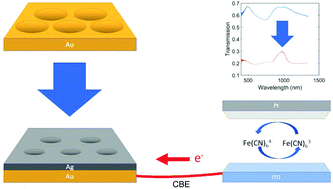Tunable optical metamaterial-based sensors enabled by closed bipolar electrochemistry†
Abstract
Enabled by the proliferation of nanoscale fabrication techniques required to create spatially-repeating, sub-wavelength structures to manipulate the behavior of visible-wavelength radiation, optical metamaterials are of increasing interest. Here we develop and characterize a chemical sensing approach based on electrochemical tuning of the optical response function of large-area, inexpensive nanoaperture metamaterials at visible and near-IR wavelengths. Nanosphere lithography is used to create an ordered array of sub-wavelength apertures in a Au film. The spacing of these apertures is established during fabrication, based on the size of the polystyrene nanospheres. Tunable shifts in the transmission spectrum can be produced post-fabrication by electrodeposition of a dissimilar metal, Ag, using the nanoaperture film as one electrode in a 2-electrode closed bipolar electrochemical (CBE) cell, altering hole size, film thickness, and film composition while maintaining hole spacing dictated by the original pattern. Optical transmission spectra acquired under galvanostatic conditions can be expressed as a linear combination of the initial and final (saturated) spectra, and the resulting response function exhibits a sigmoidal response with respect to the amount of charge (or metal) deposited. This architecture is then used to perform optical coulometry of model analytes in a CBE-based analyte-reporter dual cell device, thus expanding the capability of CBE-based sensors. Increasing the exposed electrode area of the analyte cell increases the response of the device, while modifying the circuit resistance alters the balance between sensitivity and dynamic range. These tunable nanoaperture metamaterials exhibit enhanced sensitivity compared to CBE electrochromic reporter cells to the μM to nM concentration range, suggesting further avenues for development of CBE-based chemical sensors as well as application to inexpensive, point-of-care diagnostic devices.



 Please wait while we load your content...
Please wait while we load your content...